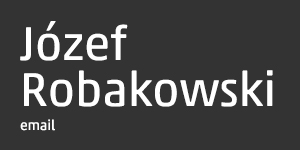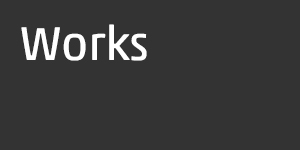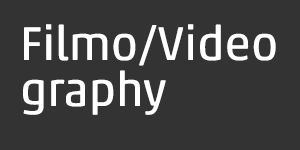Thermograms - operations on reality
Art till it hurts
Live Gallery, Lodz progressive art movement 1969-1992
'ART' friend (a memoir)
The Measure of Photography
Art is a power!
(Breaking Photography)
Jozef Robakowski, 2005–2016
How does one find a great enough strength within oneself to save one's own convictions? This question, uncompromisingly posed at the turn of the nineteen fifties and sixties, instigated our original PROGESSIVE MOVEMENT. It was born at the Nicolaus Copernicus University in Toruń as a synonym for freedom in the cynically sham-humanitarian People's Republic of Poland. To me, as someone whose entire family estate had been parcelled out under forcibly imposed, compulsory nationalisation, the matter was as clear as day, given that, from childhood on, I had had the chance of observing the socialist destruction of my homeland and family. As a child of the war, I can admit that, by reason of my birth, I was already an implacable anti-communist. My generation had its first conscious taste of derisive gestures toward the socialist authorities in 1956. For it was in that year, marching through the streets of Toruń in a spontaneously formed procession that, as part of an uncountable crowd, we could freely shout anti-government slogans. At that moment many of my friends and I were swept by the absolute conviction that, in a well-organised group, there existed a possibility of establishing a free and progressive art movement which would be anything but submissive toward the authorities of the People's Republic.
The second half of the nineteen fifties… and Polish culture, which is still under the aegis of the socialist watchword of a better world, free from capitalist violence, is experiencing an unprecedented heyday. A new 'artistic consciousness' emerges, its originality global in scale, making itself manifest in literature, poetry, music, cinema, theatre and the visual arts… Polish art, grounded in the interwar experience, begins to radiate forth. New contacts are born around the world, blowing First Secretary Gomułka's hitherto coarse, indolent, socialist culture apart. In 1958, I take the entrance exams to the Łódź Film School, at the time a unique place, an oasis of free artistic thinking. They reject me; however, being in Łódź, I visit the Muzeum Sztuki [Museum of Art] and its exhibition of works by Władysław Strzemiński, Katarzyna Kobro and Karol Hiller for the first time. These are the traditions which have raised our art to world-class status. In the future, when formulating our independent analytical programme, which was made manifest during many years of work at the Łódź Film Forms Workshop, we will draw on the consciousness of these artists, amongst others.
The nineteen sixties… I begin studying at the Nicolaus Copernicus University's Faculty of Fine Arts, specialising in museum studies, the study of historical sites and artefacts and the history of art. It is a period of unparalled creativity, because I get involved in working with a host of interdisciplinary groups, such as OKO [Eye], Zero-61, Studencki Twórczy Klub Filmowy "Pętla" [the Loop Student's Creative Film Club] and Stowarzyszenie "Krąg" [the Circle Association], for instance. Here, at this very university, we manage to break away from the official cultural policy, thanks to our outstanding faculty members. In the main, they are former lecturers from Vilnius University, which was closed down following World War II; they were transferred to the People's Republic for political reasons. To us students, their absolute ideological independence is the very model of an attitude. Professor Tymon Niesiołowski, who was a friend of Witkacy's, Professor Stefan Narębski, Professor Znamierowska-Prufferowa and Professor Jadwiga Puciata-Pawłowska, an expert in matters pertaining to the history of art at the turn of the nineteenth and twentieth centuries, shield us from the influences of socialist realism. Under the impact of their individuality, we formulate an artistic programme constructed on the basis of the Young Poland watchword, "art for art's sake". Official criticism regards the large-format, metaphoric, photographic images created within the Zero-61 students' amateur art group as anachronistic, but what is interesting is that their modern form and innovative artistic standard strike a genuine chord with the public.
Nowadays, Polish history of art experts consider those poetic photograms from the nineteen sixties to be pioneering, post-Modernist gestures because they were created with historical awareness, in the new, expressive-symbolic sense of the phrase. Back then, we had already realised that our artistic gestures would have to be made in special, atypical venues, outside the official channels of distribution. We confronted the public with those thoroughly modern photographic works and films at the combined screenings and exhibitions we set up in the early nineteen sixties, going on to hold subsequent Zero-61 exhibitions at alternative, specially adapted sites unconnected with the official venues run by the Biuro Wystaw Artyszycznych [Art Exhibitions Office]. General in nature, the shows were brief, unannounced interventions, events which took place in open, public spaces.
In 1966, along with my friends, I strove to transfer all the experience I had gained with the Zero-61 group and the Loop Students' Creative Film Club to Łódź, where, now a graduate of the Nicolaus Copernicus University, I was accepted by the institution I had dreamed of, the Film School, and began my studies there. That same year, Janusz Zagrodzki, a university colleague of mine, started work at the Museum of Art and, over the next few years, he brought more Torunians on board, including Antoni Mikołajczyk, Andrzej Różycki and Stanisław Kowalski. In the late nineteen sixties, those artistic concepts from Toruń caught on amongst other students and graduates of the Film School, such as Wojciech Bruszewski, Tadeusz Junak, Zbigniew Rybczyński, Paweł Kwiek, Ryszard Waśko, Kazimierz Bendkowski, Janusz Połom, Marek Koterski, Ryszard Gajewski, Lech Czołnowski, Ryszard Lenczewski and Krzysztof Krauze, to name but a few of the many… In 1970, we founded a creative research group. Set up as a Student Study Circle, it was completely independent of the official teaching programme and we named it 'The Film Forms Workshop'. Here is that multimedia group's first manifesto:
The WORKSHOP was established in 1970 at the incentive of a group of students and graduates of the Łódź Film, Television and Theatre School. Visual artists, musicians, photographers, poets and technicians work alongside the group's filmmakers…
The WORKSHOP makes films, recordings, television and radio broadcasts and creates art exhibitions and various kinds of artistic events and interventions…
The WORKSHOP also carries out theoretical and critical activities. It explores the potential of audiovisual art and aspires to extend it.
Nota bene! The WORKSHOP does not engage in any commercial activities and the people accomplishing its work do so completely disinterestedly.
At the outset, the head of the Chair of Film Theory and History, Professor Bolesław Lewicki, undoubtedly had a major influence on the manner and method the Workshop applied in its artistic work. In his lively and eccentric classes at the Film School, we had been analysing various editing structures and stylistic figures and drawing up visual-graphic 'scores' on paper even before the nineteen sixties had come to end. It was he who, from 1966 onward, had been setting us both classic and current reading material covering the development of cinematic and photographic thinking in the widest sense. Thanks to him, we became familiar with the writings of many a name, including Karol Irzykowski, Rudolph Arnheim, Henri Van Lier, Jean Epstein, Alicja Helman, Aleksander Jackiewicz, Renato May, Claude Lévi-Strauss, Roman Jakobson, Roman Ingarden, Edgar Morin, Adam Schaff, Herbert Marshall McLuhan, Roland Barthes and Christian Metz… Some of André Bazin's writings were published in Poland in 1963 in a book entitled Film i rzeczywiśtość [Film and Reality]; for us, it was required reading and we knew the Ontologia i język [Ontologie et langage; Ontology and Language] chapter exceptionally precisely; Wojciech Brzuszewski quoted excerpts from it in the catalogue for a Toruń exhibition, Kuźnia [Forge], in 1969. We were more interested in the views of Bazin's successors, Roland Barthes and Christian Metz, though. In this wealth of reading material, we discovered very early on that, to the scholars of the nineteen fifties and sixties, PHOTOGRAPHY was a form of reality itself. In photography, as Maya Deren, an American, avant-garde artist of the nineteen forties noted, the lens creates its own image by radiating its light onto the photosensitive negative; human participation in the process is precluded and this is where the authority of the photographic image's reality comes from. This 'materialistic' point of view, repeated by André Bazin, was relativised in the nineteen sixties by Barthes and Metz.
The late nineteen sixties… and Barthes' and Metz's new attitude to 'photographic reality' is adopted by the future members of the Workshop, in what is, by now, full awareness. As a result, I write an important piece concerning language-free film formulae and the youngest of our number, Paweł Kwiek, carries out some highly individual research into the topic with the participants in a series of exercises performed during the multifaceted Akcja [Action] carried out by the Workshop in the spaces of the Museum of Art. The relationship of the subjective to the objective is a key theme we tackle both in our writings and our practical work at the onset of the nineteen seventies. Jan Świdziński from Warsaw, who is sublimely well-versed in terms of theory, is thinking along similar lines to us. As of 1971, we begin collaborating very closely with him, inviting him to take part in the many artistic events we organise. In 1974, he writes a precision-engineered text for us; entitled Model kina [A Model for Cinema], it goes to the heart of the Workshop's film activities. He is the only person in Poland who is capable of analysing our films in the context of what is going on in the West in this regard. He also finds plenty of differences and has the skill to bring them into convincing relief. The piece is published in 1975 in "WARSZTAT" [Workshop; No. 7], a theory-oriented periodical published by the Chair of Film Theory and History at the Film School. As of the early nineteen seventies, thanks to private steps undertaken by the members of the Film Forms Workshop, our contacts both in Poland and abroad begin to multiply. In Poland, we become involved in animated and intense collaboration with Franciszka and Stefan Themerson, Jalu Kurek, Janusz Zagrodzki, Józef Patkowsk, Gerard Kwiatkowski, Stefan Morawski, Eugeniusz Rudnik, Bogusław Schaeffer, Zbigniew Dłubak, Kajetan Sosnowski, Wojciech Chyła, Andrzej Pawłowski, Tadeusz Pawłowski, Zofia Kulik, Andrzej Mroczek, Przemysław Kwiek, Jan Stanisław Wojciechowski, Andrzej Partum, Zbigniew Warpechowski, Ryszard Winiarski, Jerzy Bereś, Jan Freda and Zdzisław Piernik. Our partners abroad include Malcolm Le Grice, Richard Demarco, Birgit and Wilhelm Hein, Jorge Glusberg, Takahiko Iimura, Peter Weibel, (Valie) EXPORT, László Beke, William Raban, Paul Sharits, David Curtis, Guy Schraenen, Georg and Elisabeth Jappe, Peter Rubin, Dóra Maurer, Gabór Bódy, Marina Abramović, Jiří Valoch, Floris M. Neusüss and many another; it is simply not possible to list them all here… Our knowledge of art and culture is fed by the superb, up-to-the-minute books from Italy's Centro Dim which we obtain in exchange for our theoretic periodicals. We establish a complex system of international contacts which we maintain thanks to the Mail Art initiative that we launch at the beginning of the seventies.
One thing that emerges unambiguously from all of this is the fact that our knowledge and our general bearings in art were founded on myriad threads. The Workshop group was open; its primary aim from the very outset was interpersonal communication and the exchange of ideas. Thanks to our personal contacts, we were able to peek beyond the socialist 'wall'. So, for us, mail art was the only chance we had to elucidate our ideas, which were contained in a host of documentation, photographs, writings, films and video cassettes.
It is worth noting that analytical-rational practices had first emerged amongst the groups of artists in question in the nineteen sixties and had a great many adherents, particularly in the artistic, multimedia Circle Association. At this point, I should mention something about my first works, including the ones I took with me to the entrance exam to the Film School in the academic year 1958/1959… Feet (1959), Indifferent Seascape (1959), three painterly luxographs Carmine, Labyrinth and Las [Forest], all created in 1958 and a photomontage entitled Drunkard (1959), but, above all, my first photographic object, Colander (1960)… have the hallmarks of Neo-Dadaism. Lucjan Oczkowski's 1962 film Śmierć Andersena [Andersen's Death] and my precisely constructed film collage 6 000 000 of the same year both feature a metaphorical structure of the found-footage type, which was a gesture unique for its time. Wiesław Wojczulanis' early synthetic photographic work from that period, akin to American photography such as that of Edward Weston and his halved cabbage motif, for instance, is also important. Another essential gesture of an analytical-rational nature is something we called REFERENCES, which appeared for the first time in my Blacksmith (1962). An image of a blacksmith from Człuchów, a small town in north-west Poland, mechanically set into a large-format photograph of his work-worn hand, the work is now held in the collections of the Regional Museum in Toruń, but it was also reproduced in a book by Juliusz Garztecki, Trzecie Oko [The Third Eye], in 1975. However, the full-blown REFERENCES would not appear until later, in the form of a joint, open-air event that took place during the Zero-61 group's anniversary exhibition, which went on show in the courtyard of Torun's Collegium Minus. That was when we juxtaposed our work with elements of the natural environment. This precursory rational gesture was mentioned by two Warsaw critics in their reviews of the exhibition, namely, Juliusz Garztecki in the weekly "Kultura" [Culture; No. 9, 1966] and Bogdan Łopieński in the monthly "Fotografie" [Photography; No. 8, 1966]. I described this conceptual problem, REFERENCES, in an "account of maturing" which was published in a book entitled Dekada 1980-1990 [A Decade. 1980 to 1990] published by Moje Archiwum [My Archive; Koszalin, 1990]. I also discussed it in a piece entitled Instalacje [Installations], which appeared in Sztuka instalacji [Installation Art], volume VII of Rzeżba Polska [Polish Sculpture] an annual published by the Centre of Polish Sculpture in the east-central Polish village of Orońsko. REFERENCES would make another appearance in 1966, in a different form, at the multimedia exhibition held by the Circle Association in Dwór Artusa [Artus Court] in Toruń. What we did then was borrow various kinds of 'curiosities of nature' from the Earth Sciences Department, objects such as a two-headed calf, taxidermied birds, human and animal skeletons and a massive whale vertebra, for instance, and set them up in a head-on confrontation with our works, which were displayed in the depths of a barely lit gallery.
1967… and further Neo-Dadaist doings occur in profusion at the Circle Association's second exhibition, held at the Regional Museum in Toruń. In this case, what excites the most comment is the figure of a fictional artist, Józef Korbiela, who exhibits a number of works, including an object entitled Dama z naszyjnikiem [Lady with a Necklace], Epitafium Jana Gnata [Epitaph for Jan Gnat] and a series of superbly executed pastiches, all of them in the styles typical of the works of Nicolaus Copernicus University professors Bronisław Kierzkowski, Stefan Kościelecki and Mieczysław Wiśniewski. The photographs of two other members of the group, Jerzy Wardak and Andrzej Różycki, gravitate toward surrealism; this is particularly the case with the latter's 1965 film, Na wspomnieniach fali [On a Wave of Memories], a composition of pre-war postcards rhythmically edited to the strains of an old song, Cóż bez miłości wart jest świat [What is the World Worth Without Love]. Later on, Antoni Mikołajczyk and Michał Kokot will also feel very much at home with this kind of film collage. So, a critical and ironic attitude appears in a great many of the works by members of Zero-61 from its very inception.
1967… and even before the Subiektywna Fotografia [Subjective Photography] exhibition of 1968, I am personally becoming interested in THE PROBLEM OF DUALITY; the juxtaposition of the real world and the ostensible in mirrored reflections, in a variety of interactive objects, films and trick photographs which I am engaged in at the Film School. The grand photographic object Bicycle Wheel (1969) derives from this inclination and, being a tautological work, it is also a harbinger. To create it, I juxtapose a real bicycle wheel, a white one, with a luxographic image of that object. During this period, my research-oriented approach is also made manifest in other photographs, such as Ten Fields of Focus (1969) and Four Fields of Focus (1969). The first film to be made by the Film Forms Workshop is analytic in nature, as well. Entitled The Market (1970), I make it together with two fellow members, Tadeusz Junak and Ryszard Meissner, shooting it on the Red Market Square in Łódź. The same is true of Wojciech Bruszewski's spatial work Ear (1971), which goes on show at the Fotografów Poszukujących [Questing Photographers] exhibition at Warsaw's Galeria Współczesna [Contemporary Art Gallery]. Antoni Mikołajczyk and Paweł Kwiek are also engaged in similar exercises.
It was in the closing years of the nineteen sixties, before the Film Forms Workshop was even founded, that we discovered the precursors of analytical photographic sequences together in the animated film classes taught by Jerzy Kotowski, Ph.D. We were most fascinated by Eadweard Muybridge, Thomas Eatkins, Étienne-Jules Marey and the Italian Futurists. It was Zbigniew Rybczyński who delved the most deeply into the style and thematic content of their work; his visual 'scores' aroused widespread admiration. Paweł Kwiek forged a place of his own in the Workshop, collaborating with the students of the Warsaw Academy of Fine Arts as a camera operator. That group, which included Jan Stanisław Wojciechowski, Zofia Kulik, Przemysław Kwiek and Krzysztof Zarębski, was working on the creative development of Professor Oskar Hansen's spatial concept. Their collaborative films, which analysed the interesting notion of Open Form, were shown at the Film School during an artistic gathering entitled Ósme Kino [The Eighth Cinema] in 1971 and at the Festival of Films about Art held in the town of Zakopane in the Tatra Mountains the following year.
The first years of the nineteen seventies… and there is an extraordinary explosion of artistic activity amongst the students and graduates of Poland's HEIs. It is made manifest at the Arts Schools Students' Festival in the south-western town of Nowa Ruda in 1971, where we meet Jan Świdziński and, without further ado, invite him to Łódź for The Eighth Cinema in the autumn. We start touring our films and sets of photographs to numerous galleries around the country, all of them private and original in nature. We visit quite a few cities; Krakow, Wrocław, Gdańsk, Lublin, Poznań, Warsaw, Toruń and Elbląg. It is in Elbląg that, in 1973, together with Gerard Kwiatkowski and at our own expense, we organise a grand, international festival of 'extended cinema', KINOLABORATORIUM [CINEMALABORATORY], held at the Galeria EL [EL Gallery] as its V Biennale Form Przestrzennych [5th Spatial Forms Biennale]. With our Eighth Cinema, we stand in opposition to a group of young filmmakers who were being endorsed and promoted by both the official line in film criticism and the state cinema organisation. The term coined to speak of the group was 'the Third Cinema' and it was represented by the award winners at the official festivals, namely, documentarists Tomasz Zygadło. Grzegorz Królikiewicz and Krzysztof Kieslowski. We have our supporters on the editorial team of a Krakow weekly, "Student", where we succeed in having two interventional pieces published; one is written collectively and entitled Oświadczenie [Declaration] and the other is my Paszkwil na Kinematografię [Lampoon on Cinema]. Editors Krzysztof Miklaszewski, Tadeusz Nyczek and Maciej Szybist support us and their articles subscribe to our ideas and the interventional activities we undertake during the uncritical state festival celebrations in Gdańsk, in the western village of Łagów and in Zakopane. With our ruthless interventions, we rain ridicule down upon the makers of The Woodpecker, Jerzy Gruza and Krzysztof Teodor Toeplitz, in Gdańsk. On another occasion, we maliciously upbraid the 'irredeemables'; Krzysztof Zanussi, Andrzej Konic, Bohdan Poręba, Janusz Nasfeter, Sylwester Chęciński and many another popular luminary of our state-run cinema. During the course of these numerous interventions, a conflict of opinions arises. 'Our' cinema firmly renounces commercial and political intentions; it is to be the discovery of genuine reality and of the many and varied mechanisms which influence it. We decisively walk away from formalistic 'operations on reality' in the Romantic style of Tadeusz Kantor. In our work, we enter into the natural urban environment; one such instance occurs on the Red Market Square in Łódż during our Wyprzedaż mebli [Furniture Sale; 1971]. One autumn morning, we allow Mr Wacław Antczak, posing as a trader, to display all the sundry items left to me by my aunt and to sell them at absurdly low prices. The sprawling stall, groaning with cupboards, mirrors, sofas, cans of food from the United Nations Relief and Rehabilitation Agency and old books, is besieged by bystanders and people ready to buy. On the dot of noon, the trader disappears. It turns out that the rest of Aunt Anna Konarzewska's 'estate' is stolen in a flash; all that remains is an old sofa which some hooligan has set fire to.
We observe other people's reactions, talk to them, have discussions with them. We are interested in them, testing out our patterns of reflex and habit. We hand the FIELD OF ART to others. For instance, we instigate a happening based on an idea conceived by Andrzej Barański; it involves a collective recitation of Ode to Youth by one of Poland's 'Three National Bards', the Romantic poet Adam Mickiewicz, and is accomplished on a word-by-word basis, with each successive word being spoken by randomly encountered passers-by. During the Workshop's Akcja at the Museum of Art, we carry out what is possibly the world's first television transmission from an urban landscape to be broadcast solely by artists. Using a professional mobile broadcasting unit, we transmit three television images, complete with professional sound, over the course of twelve hours. The images originate from a private flat, a carpenter's workshop and at a junction of the streets leading to the room at the museum. Before we ever set about this, we announce a general "competition for an artistic signature" in the local press. It enjoys enormous interest and, as a result, we organise an exhibition of the works submitted. They go on show at the Museum of Art and we present the winners with much-prized books as award. On another occasion, Paweł Kwiek launches a campaign in a number of provincial centres in the vicinity of Łódź with the aim of getting school pupils to make film études. Our entire group performs in various cities, appearing with Mr Edward Kowalski's Łódź Pensioners' Theatre. We become his fervent disciples, performing his play, Kariera i śmierć Adolfa Hitlera [The Career and Death of Adolf Hitler] in the Film School's theatre and at the Museum of Art during the Workshop's Akcja. Just before the unexpected death of our 'professor' and amateur 'Renaissance man', Wacław Antczak, we dedicate a special film to him, Reinkarnacja [Reincarnation; 1974]. Time and again, thanks to our collaboration with myriad artists, by no means all of them possessed of a professional artistic background or a fundamental technical grounding, we succeed in stepping out into new creative territories which our imaginations, drilled as they are by education, have never foreseen. Our efforts to push beyond those limits of imagination are the source of our greatest artistic satisfaction. In the name of the self-education we prefer, we organise national semiological sessions and conferences on the premises of the Film School. We publish our own theoretic periodicals and, together, we analyse a multitude of archived films dating from the era of the first French, German and Russian avant-garde. We study stylistic figures in works by 'Soviet School' film artists Dziga Vertov, Sergei Eisenstein and Vsevolod Pudovkin. We go to Wrocław to see Jerzy Grotowski's theatre productions. In the Film School archives, we discover Przygoda człowieka poczciwego [The Adventure of an Honest Man; 1937], Franciszka and Stefan Themerson's sole surviving pre-war film; we screen it at the international KINOLABORATORIUM festival in Elbląg, together with what is, to us, a unique work, The Colour of Pomegranates, directed by Sergei Parajanov, the maker of 'individual cinema' for whom we feel a great kinship and who is being so cruelly persecuted by the Soviet authorities. We present our controversial études at the film schools in Moscow and the German Democratic Republic and we keep in regular touch with Hungarian filmmakers, as a result of which, we establish new and interesting contacts with young film artists from the 'socialist camp'.
During a visit to Łódź, Edinburgh gallery owner Richard Demarco discovers the Film Form Workshop and invites us to take part in a sweeping presentation of Polish art, ATELIER 72, at the Edinburgh Festival. There, our work comes face to face with that of outstanding Polish artists and the worldwide avant-garde for the first time. Now on an 'artistic gallop', we visit one Western European city after another at the invitation of curators and artists. We go to Antwerp, Amsterdam, Kassel, London, Paris, Copenhagen, Cologne, Düsseldorf, Stockholm, Padua, Venice, Milan, Vienna and West Berlin, but we also tour our work to East Berlin, Moscow, Prague, Budapest, Zagreb, Belgrade…
In effect, our multimedia, artistic group created an enormous body of work, which received its first monographic show, curated by Professor Ryszard Kluszczyński, at the Film Forms Workshop Exhibition, held at the Centre for Contemporary Art in Warsaw in 2000. Several of the vast rooms in Ujazdów Castle, where the centre makes its home, were filled with works of varying kinds. It was projections that dominated, though; sets of photographs, spatial installations, interactive objects, television recordings and broadcasts and visual texts. Transitory printed material, unique publications, posters and photographic documentation constituted a separate section of the exhibition. At present, the story of that unique group has its own monographs by Ryszard Kluszczyński, Łukasz Ronduda, Alicja Cichowicz, Ryszard Waśko and the author of this piece, Józef Robakowski. The group's films are distributed in Poland and abroad by Electronic Arts Intermix of New York, arousing an ever growing interest. A television programme about the WORKSHOP group, directed by Maria Waśko and broadcast on TVP Kultura, the Telwizja Polska [Polish Television] culture channel, has enjoyed great success. Nowadays, so many years after that fervent activity, I often ask myself a question; how was all of it possible in provincial Poland, subjugated to the socialist ideology imposed on us from outside? However, to this day, I remain convinced that ART IS POWER! For it was art which was always the mainstay of FREEDOM for us, a synonym of our faith that artists can influence the image of the World and that what remains with them to the very end, as their then final chance, is their uncompromisingly held belief that THEY are still necessary to someone.
English translation by Caryl Swift (2016)







